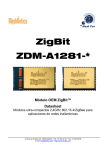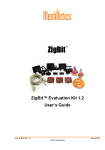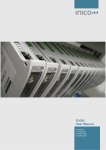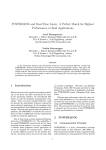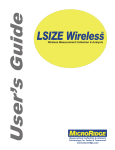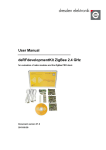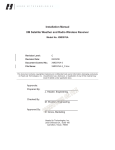Download ZigBit™ OEM Modules
Transcript
ZigBit™ OEM Modules ZDM-A1281-* Ultra-Compact 2.4GHz 802.15.4/ZigBee Modules for Wireless Networking Applications Product Datasheet DOC. M-251~01 V.1.15 WWW.MESHNETICS.COM © 2008 MeshNetics MARCH 2008 Zi gBi t™ O EM M odule s Product Datasheet Table of Contents Summary ............................................................................................................................................................. 3 Applications ........................................................................................................................................................ 3 Key features ........................................................................................................................................................ 4 Benefits................................................................................................................................................................ 4 ZigBit™ Module Overview ................................................................................................................................. 4 Specifications ..................................................................................................................................................... 6 Absolute Maximum Ratings**............................................................................................................................ 7 Physical/Environmental Characteristics and Outline ..................................................................................... 8 Pin Configuration................................................................................................................................................ 9 Mounting Information....................................................................................................................................... 13 Sample Antenna Reference Designs .............................................................................................................. 14 Agency Certifications....................................................................................................................................... 20 Related Documents .......................................................................................................................................... 22 Ordering Information........................................................................................................................................ 23 Disclaimer.......................................................................................................................................................... 24 Trademarks ....................................................................................................................................................... 24 Technical Support ............................................................................................................................................ 24 Contact Information.......................................................................................................................................... 24 © 2008 MeshNetics Page 2 of 24 Zi gBi t™ O EM M odule s Product Datasheet Summary ZigBit™ is an ultra-compact, low-power, high-sensitivity 2.4GHz 802.15.4/ZigBee OEM module from MeshNetics, based on the innovative Atmel’s mixed-signal hardware platform. It is designed for wireless sensing, control and data acquisition applications. ZigBit modules eliminate the need for costly and time-consuming RF development, and shorten time to market for a wide range of wireless applications. Two different versions of ZigBit modules are available: ZDM-A1281-B0 module with balanced RF port for applications where the benefits of PCB or external antenna can be utilized and ZDM-A1281-A2 module with dual chip antenna satisfying the needs of size sensitive applications. Applications ZigBit module ships with robust 802.15.4/ZigBee stack that supports a self-healing, self-organizing mesh network, while optimizing network traffic and minimizing power consumption. MeshNetics offers three stack configurations: ZigBeeNet, SerialNet and OpenMAC. ZigBeeNet is a certified, ZigBee PRO software development platform supporting reliable, scalable, and secure wireless applications running on MeshNetics ZigBit modules. SerialNet allows programming of the module via serial AT-command interface. OpenMAC is MeshNetics’ open source implementation of IEEE802.15.4 MAC layer intended for embedded software experts and enthusiasts. The applications include, but are not limited to: • • • • • Building automation & monitoring • Lighting controls • Wireless smoke and CO detectors • Structural integrity monitoring HVAC monitoring & control Inventory management Environmental monitoring Security © 2008 MeshNetics • • • Water metering Industrial monitoring • Machinery condition and performance monitoring • Monitoring of plant system parameters such as temperature, pressure, flow, tank level, humidity, vibration, etc. Automated meter reading (AMR) Page 3 of 24 Zi gBi t™ O EM M odule s Key features • • • • • • • • • • • • • Ultra compact size (24 x 13.5 mm for ZDM-A1281-A2 module and 18.8 x 13.5 mm for ZDM-A1281-B0 module) Innovative (patent-pending) balanced dual chip antenna design with antenna gain of approximately 0 dBi (for ZDM-A1281-A2 version) High RX sensitivity (-101 dBm) Outperforming link budget (104 dB) Up to 3 dBm output power Very low power consumption (< 6 µA in sleep mode) Ample memory resources (128K bytes of flash memory, 8K bytes RAM, 4K bytes EEPROM) Wide range of interfaces (both analog and digital): • 9 spare GPIO, 2 spare IRQ lines • 4 ADC lines + 1 line for supply voltage control (up to 9 lines with JTAG disabled) • UART with CTS/RTS control • USART 2 • IC • SPI • 1-Wire • Up to 30 lines configurable as GPIO Capability to write own MAC address into the EEPROM Optional antenna reference designs IEEE 802.15.4 compliant 2.4 GHz ISM band Product Datasheet Benefits • • • • • • • • • Less physical space constraints Best-in-class RF link range Longer battery life Easy prototyping with 2-layer PCB More memory for user software application Mesh networking capability Easy-to-use low cost Evaluation Kit Single source of support for HW and SW Worldwide license-free operation ZigBeeNet embedded software, including UART bootloader and AT command set ZigBit™ Module Overview ZigBit is a low-power, high-sensitivity IEEE802.15.4/ ZigBee-compliant OEM module. This multi-functional device occupies less than a square inch of space, which is comparable to a typical size of a single chip. Based on a solid combination of Atmel’s latest AVR Z-Link hardware platform [1], the ZigBit offers superior radio performance with exceptional ease of integration. ZigBit contains Atmel’s ATmega1281V Microcontroller [1] and AT86RF230 RF Transceiver [2]. The module features 128kb flash memory and 8 kb RAM. The ZigBit already contains a complete RF/MCU-related design with all the necessary passive components included. The module can be easily mounted on a simple 2-layer PCB. Compared to a single-chip, a module-based ZigBit modules comply with the FCC (Part 15), IC and solution offers considerable savings in development time ETSI (CE) rules applicable to the devices radiating in and NRE cost per unit during the design, prototyping, uncontrolled environment. For details, see section and mass production phases of product development. Agency Certifications below. Innovative (patent-pending) dual chip antenna design in ZigBit fully satisfies the requirements of the “Directive ZDM-A1281-A2 module eliminates the balun and 2002/95/EC of the European Parliament and the Council achieves good performance over ZigBee frequency of 27January 2003 on the restriction of the use of certain band. hazardous substances in electrical and electronic equipment” (RoHS). MeshNetics provides fully compliant product in all regions where the directive is enforced July 1, 2006. © 2008 MeshNetics Page 4 of 24 Zi gBi t™ O EM M odule s To jumpstart evaluation and development, MeshNetics also offers a complete set of evaluation and development tools. The ZigBit Development Kit [6] comes with everything you need to create custom applications around ZigBit module. The kit features MeshBean development boards with an easy-to-access extension connector for attaching third party sensors and other peripherals, and a JTAG connector for easy application uploading and debugging. The kit also includes sample applications in C to speed up application development, open source hardware interface layer and reference drivers for the all the module interfaces, intuitive development environment from Atmel, and comprehensive set of application notes and product tutorials. ZigBit modules comes bundled with ZigBeeNet, a 2nd generation embedded software stack from MeshNetics. ZigBeeNet is fully compliant with ZigBee PRO and ZigBee standards for wireless sensing and control [3], [4], [5] and it provides an augmented set of APIs which, while maintaining 100% compliance with the standard, offer extended functionality designed with developer's convenience and ease-of-use in mind. Depending on end-user design requirements, ZigBit can operate as a self-contained sensor node, where it would function as a single MCU, or it can be paired with a host processor driving the module over a serial interface. In the former case, a user application may be used with the ZigBeeNet software allowing customization of embedded applications through ZigBeeNet’s C API. Product Datasheet ZDM-A1281-B0 Block Diagram VCC (1.8 – 3.6V) IRQ UART USART/SPI I2C JTAG Analog ATmega1281 Micro controller GPIO AT86RF230 RF Transceiver RF I/O SPI Bus ZDM-A1281-A2 Block Diagram VCC (1.8 – 3.6V) IRQ UART USART/SPI I2C JTAG Analog ATmega1281 Micro controller GPIO AT86RF230 RF Transceiver Chip Antenna SPI Bus ZigBeeNet™ Block Diagram In the latter case, the host processor controls data transmission and manages module peripherals via an extensive set of SerialNet AT commands. Thus, no firmware customization is required for a successful module design-in. Additionally, third-party sensors can be connected directly to the module, thus expanding the existing set of peripheral interfaces. The over-the-air control via AT-commands eases network configuration and speeds up application prototyping. It also enables wireless module configuration during OEM massproduction process, providing a flexible commissioning protocol for installation and maintenance of ZigBit-based devices. © 2008 MeshNetics Page 5 of 24 Zi gBi t™ O EM M odule s Product Datasheet Specifications Test Conditions (unless otherwise stated): Vcc= 3 V, f=2.45 GHz, Tamb= 25 °C Module Operating Conditions Parameters Range Unit 1.8 to 3.6 V Current Consumption: RX mode 19 mA see Note Current Consumption: TX mode 18 mA see Note Current Consumption: Radio is turned off, MCU is active for 50% of the time. 14 mA see Note Current Consumption: Power Save mode 6 μA see Note Supply Voltage (Vcc) Condition Note: Parameters specified above are measured under the following conditions: • ZigBeeNet software is running at 4 MHz clock rate, DTR line management is turned off • all interfaces are set to the default state (see Pin Assignment Table) • output TX power is 0 dBm • JTAG is not connected • Vcc = 3.0 V • actual current consumption depends on multiple factors, including but not limited to the board design and materials, extra MCU load by user’s application, peripherals usage, EEPROM reading/writing, ZigBeeNet settings, network activity and so on. RF Characteristics Parameters Frequency Band Range Unit 2.400 to 2.4835 GHz Condition Number of Channels 16 Channel Spacing 5 MHz -17 to +3 dBm Adjusted in 16 steps - 101 dBm PER = 1% On-Air Data Rate 250 kbps TX Output / Rx Input Nominal Impedance 100 Ohms Transmitter Output Power Receiver Sensitivity © 2008 MeshNetics For balanced output Page 6 of 24 Zi gBi t™ O EM M odule s Product Datasheet ATmega1281V Microcontroller Characteristics Parameters Range Unit 128K bytes On-Chip RAM Size 8K bytes On-Chip EEPROM Size 4K bytes 4 MHz On-Chip Flash Memory Size Operation Frequency Condition Module Interfaces Characteristics Parameters Range Unit 38.4 kbps 10 / 200 Bits / μs >1 MOhm 1.0 to Vcc - 0.3 V 0 ÷ Vref V 222 kHz GPIO Output Voltage (High/Low) 2.3 / 0.5 V Real Time Oscillator Frequency 32.768 kHz UART Maximum Baud Rate ADC Resolution / Conversion Time ADC Input Resistance ADC Reference Voltage (Vref) ADC Input Voltage 2 I C Maximum Clock Condition In the single conversion mode (-10 / 5 mA) Absolute Maximum Ratings** Parameter Voltage of any Pin except RESET with respect to Ground Min Value -0.5 V Max Value Vcc + 0.5 V DC Current per I/O Pin 40 mA DC Current D_VCC and DGND Pins 200 mA Input RF Level +10 dBm **Absolute Maximum Ratings are the values beyond which damage to the device may occur. Under no circumstances must the absolute maximum ratings given in this table be violated. Stresses beyond those listed under “Absolute Maximum Ratings” may cause permanent damage to the device. This is a stress rating only. Functional operation of the device at these or other conditions, beyond those indicated in the operational sections of this specification, is not implied. Exposure to absolute maximum rating conditions for extended periods may affect device reliability. Attention! ZigBit is an ESD-sensitive device. Precaution should be taken when handling the device in order to prevent permanent damage. © 2008 MeshNetics Page 7 of 24 Zi gBi t™ O EM M odule s Product Datasheet Physical/Environmental Characteristics and Outline Parameter Size Value Notes 18.8 x 13.5 x 2.8 mm ZDM-A1281-B0 24.0 x 13.5 x 2.8 mm ZDM-A1281-A2 1.3 g ZDM-A1281-B0 1.5 g ZDM-A1281-A2 -20°C to +70°C -40°C to +85°C operational * Weight Operating Temperature Range Operating Relative Humidity Range no more than 80% ZDM-A1281-B0 Mechanical Drawing 18,8 ±0,2 17,3±0,2 1 26 43 25 44 12,0±0,2 13,5±0,2 48 19 18 0,8-0.2 All dimensions are in millimeters 2,0±0,1 ±0,1 1,0 typ 0,7 ZDM-A1281-A2 Mechanical Drawing 24.0±0.2 17.3±0.2 1 26 43 25 12.0±0.2 13,5±0,2 19 18 0.8-0.2 All dimensions are in millimeters * 1.0 typ ±0.1 0.7 2.0±0.1 Minor degradation of clock stability may occur © 2008 MeshNetics Page 8 of 24 © 2008 MeshNetics IRQ_6 IRQ_7 GPIO8 USART0_EXTCLK USART0_TXD USART0_RXD UART_DTR OSC32K_OUT GPIO2 GPIO1 GPIO0 SPI_MOSI SPI_MISO SPI_CLK 18 17 16 15 14 13 12 11 10 9 RESET DGND CPU_CLK I2C_CLK I2C_DATA UART_TXD UART_RXD UART_RTS IRQ_6 IRQ_7 GPIO8 USART0_EXTCLK USART0_TXD USART0_RXD UART_DTR GPIO_1WR AGND A_VREF BAT ADC_INPUT_1 ADC_INPUT_2 ADC_INPUT_3 JTAG_TCK 44 45 46 47 48 OSC32K_OUT GPIO2 GPIO1 GPIO0 SPI_MOSI SPI_MISO SPI_CLK DGND CPU_CLK I2C_CLK I2C_DATA UART_TXD UART_RXD UART_RTS UART_CTS GPIO6 GPIO7 RESET 18 17 16 15 14 13 12 11 10 9 GPIO_1WR AGND D_VCC A_VREF DGND BAT D_VCC ADC_INPUT_1 DGND ADC_INPUT_2 GPIO5 ADC_INPUT_3 GPIO3 JTAG_TCK GPIO4 JTAG_TDO D_VCC UART_CTS D_VCC JTAG_TDO DGND JTAG_TDI JTAG_TMS DGND GPIO6 GPIO7 GPIO5 JTAG_TDI JTAG_TMS GPIO3 25 24 23 22 21 20 19 GPIO4 25 24 23 22 21 20 19 Zi gBi t™ O EM M odule s Product Datasheet Pin Configuration ZDM-A1281-B0 Pinout 8 7 6 5 4 3 2 1 8 7 6 5 4 3 2 1 RF_GND RFN_IO RF_GND RFP_IO RF_GND 26 27 28 29 30 31 32 33 34 35 36 37 38 39 40 41 42 43 ZDM-A1281-A2 Pinout 26 27 28 29 30 31 32 33 34 35 36 37 38 39 40 41 42 43 Page 9 of 24 Zi gBi t™ O EM M odule s Product Datasheet Pin Assignment Table Default State after power on Notes, see the list below Connector Pin Pin Name Description I/O 1 SPI_CLK Reserved for stack operation O 4 2 SPI_MISO Reserved for stack operation I/O 4 3 SPI_MOSI Reserved for stack operation I/O 4 4 GPIO0 General purpose digital input/output 0 I/O tri-state 2, 3, 4, 7 5 GPIO1 General purpose digital input/output 1 I/O tri-state 2, 3, 4, 7 6 GPIO2 General purpose digital input/output 2 I/O tri-state 2, 3, 4, 7 7 OSC32K_OUT 32.768 kHz clock output. O 4, 5 8 RESET Reset input (active low). I 4 9, 22, 23 DGND Digital ground 10 CPU_CLK RF clock output. When module is in active state, 4 MHz signal is present on this line. While module is in the sleeping state, clock generation is stopped also. O 11 I2C_CLK I2C serial clock output O tri-state 2, 3, 4, 7 I/O tri-state 2, 3, 4, 7 2 4 12 I2C_DATA I C serial data input/output 13 UART_TXD UART receive input I tri-state 1, 2, 3, 4, 7 14 UART_RXD UART transmit output O tri-state 1, 2, 3, 4, 7 15 UART_RTS RTS input (Request To Send) for UART hardware flow control. Active low. I tri-state 16 UART_CTS CTS output (Clear To Send) for UART hardware flow control. Active low. O tri-state 17 GPIO6 General purpose digital input/output 6 I/O tri-state 2, 3, 4, 7 18 GPIO7 General purpose digital input/output 7 I/O tri-state 2, 3, 4, 7 19 GPIO3 General purpose digital input/output 3 I/O tri-state 2, 3, 4, 7 20 GPIO4 General purpose digital input/output 4 I/O tri-state 2, 3, 4, 7 21 GPIO5 General purpose digital input/output 5 I/O tri-state 2, 3, 4, 7 24, 25 D_VCC Digital supply voltage (Vcc) 26 JTAG_TMS JTAG test mode select I 2, 3, 4, 6 27 JTAG_TDI JTAG test data input I 2, 3, 4, 6 28 JTAG_TDO JTAG test data output O 2, 3, 4, 6 29 JTAG_TCK JTAG test clock I 2, 3, 4, 6 30 ADC_INPUT_3 ADC input channel 3 I tri-state 2, 3, 7 31 ADC_INPUT_2 ADC input channel 2 I tri-state 2, 3, 7 32 ADC_INPUT_1 ADC input channel 1 I tri-state 2, 3, 7 33 BAT ADC input channel 0. Used for battery level measurement. This pin level equals to VCC / 3. I tri-state 34 A_VREF Output/Input reference voltage for ADC I/O tri-state © 2008 MeshNetics 2, 3, 4, 7 2, 3, 4, 7, 8 9 2, 3, 7 Page 10 of 24 Zi gBi t™ O EM M odule s Connector Pin Product Datasheet I/O Default State after power on Notes, see the list below Pin Name Description 35 AGND Analog ground 36 GPIO_1WR 1-Wire Interface 37 UART_DTR DTR input (Data Terminal Ready) for UART. Active low. I tri-state 38 USART0_RXD UART/SPI receive pin I tri-state 2, 3, 4, 7 39 USART0_TXD UART/SPI transmit pin O tri-state 2, 3, 4, 7 40 USART0_EXTCLK UART/SPI external clock I tri-state 2, 3, 4, 7 41 GPIO8 General purpose digital input/output 8 I/O tri-state 2, 3, 4, 7 42 IRQ_7 Digital input interrupt request 7 I tri-state 2, 3, 4, 7 43 IRQ_6 Digital input interrupt request 6 I tri-state 2, 3, 4, 7 44, 46, 48 RF_GND RF analog ground 45 RFP_IO Differential RF input/output. I/O 10 47 RFN_IO Differential RF input/output. I/O 10 I/O 2, 3, 4, 7 2, 3, 4, 7 10 Notes: 1. The UART_TXD pin is intended for input (i.e. its designation as “TXD” implies some complex system containing ZigBit as its RF terminal unit), while UART_RXD pin, vice versa, is for output. 2. Most of pins can be configured for general purpose I/O or for some alternate functions as described in details in the ATmega1281V Datasheet [1]. 3. GPIO pins can be programmed either for output, or for input with/without pull-up resistors. Output pin drivers are strong enough to drive LED displays directly (refer to figures on pages 387-388, [1]). 4. All digital pins are provided with protection diodes to D_VCC and DGND 5. It is strongly recommended to avoid assigning an alternate function for OSC32K_OUT pin because it is used by ZigBeeNet. However, this signal can be used if another peripheral or host processor requires 32.768 kHz clock, otherwise this pin can be disconnected. 6. Normally, JTAG_TMS, JTAG_TDI, JTAG_TDO, JTAG_TCK pins are used for on-chip debugging and flash burning. They can be used for A/D conversion if JTAGEN fuse is disabled. 7. The following pins can be configured with the ZigBeeNet software to be general-purpose I/O lines: GPIO0, GPIO1, GPIO2, GPIO3, GPIO4, GPIO5, GPIO6, GPIO7, GPIO8, GPIO_1WR, I2C_CLK, I2C_DATA, UART_TXD, UART_RXD, UART_RTS, UART_CTS, ADC_INPUT_3, ADC_INPUT_2, ADC_INPUT_1, BAT, UART_DTR, USART0_RXD, USART0_TXD, USART0_EXTCLK, IRQ_7, IRQ_6. Additionally, four JTAG lines can be programmed with software as GPIO as well, but this requires changing the fuse bits and will disable JTAG debugging. 8. With ZigBeeNet, CTS pin can be configured to indicate sleep/active condition of the module thus providing mechanism for power management of host processor. If this function is necessary, connection of this pin to external pull-down resistor is recommended to prevent the undesirable transients during module reset process. 9. Using ferrite bead and 1 µF capacitor located closely to the power supply pin is recommended, as shown below. 1,8...3,6 V D_VCC DGND 10. Pins 44 through 48 are not designed for the ZDM-A1281-A2 module. Note these pins are used in ZDM-A1281-B0, see them in antenna schematics below. © 2008 MeshNetics Page 11 of 24 Zi gBi t™ O EM M odule s Product Datasheet Typical Antenna Schematics RF_GND RFP_IO RF_GND RFN_IO RF_GND Balun TDK’s HHM1520 4 5 2 44 45 46 47 48 two capacitors* SMA Connector 3 1 6=Not Connected For ZDM-A1281-B0 combined with External Antenna *) 0402,22pF+/-5%, NP0 High Freq Grade Murata GRM1555C1H220JZ0D © 2008 MeshNetics Page 12 of 24 Zi gBi t™ O EM M odule s Product Datasheet Mounting Information ZDM-A1281-B0 PCB Recommended Layout, Top View 19.7 1.0 1 25 44 14.5 48 19 18 0.8 43 1.2 26 All dimensions are in millimeters ZDM-A1281-A2 PCB Recommended Layout, Top View 0.5 1.0 1 25 14.5 19 18 24.0 0.8 26 All dimensions are in millimeters 43 1.2 0.9 The above diagrams show the PCB layout recommended for ZigBit module. Neither via-holes nor wires are allowed on the PCB upper layer in area occupied by the module. As a critical requirement, RF_GND pins should be grounded via several holes to be located right next to the pins thus minimizing inductance and preventing both mismatch and losses. © 2008 MeshNetics Page 13 of 24 Zi gBi t™ O EM M odule s Product Datasheet Sample Antenna Reference Designs This section presents PCB designs which combine ZigBit with different antennas: PCB onboard antenna, external antenna and dual chip antenna. These antenna reference designs are recommended for successful design-in. PCB Layout: Symmetric Dipole Antenna recommended for ZDM-A1281-B0 Top side 21,0 5,2 25,0 1,4 1,2 1,2 2,6 3,3 4,6 3,3 1.8 1,8 1,9 1,2 4,0 6,5 11,5 0,7 3,0 2 through holes O3,0 2,0 ZigBit Module Metallized through holes O0.3~0.4 Recommended step 1 mm Two capacitors 0402,22pF+/-5%, NP0 High Freq Grade Murata GRM1555C1H220JZ0D Area supporting the components Bottom side Metallization, wires, through holes are unallowed 52,5 11,5 1,2 Metallization Material: FR-4. thickness 1.6 mm Metallization: 35 um Coating: HASL, solder mask All dimensions are in millimeters ZigBit Module 60,0 © 2008 MeshNetics Page 14 of 24 Zi gBi t™ O EM M odule s Product Datasheet The symmetric dipole antenna above has been tuned for the particular design. The ‘cut-and-paste’ approach would not guarantee optimal performance because of multiple factors affecting proper antenna match, hence, affecting the pattern. The particular factors are the board material and thickness, shields, the material used for enclosure, the board neighborhood, and other components adjacent to antenna. General recommendations: • Metal enclosure should not be used. Using low profile enclosure might also affect antenna tuning. • Placing high profile components next to antenna should be avoided. • Having holes punched around the periphery of the board eliminates parasitic radiation from the board edges also distorting antenna pattern. • ZigBit module should not be placed next to consumer electronics which might interfere with ZigBit’s RF frequency band. © 2008 MeshNetics Page 15 of 24 Zi gBi t™ O EM M odule s © 2008 MeshNetics Product Datasheet Page 16 of 24 Zi gBi t™ O EM M odule s Product Datasheet PCB Layout with 50 Ohm External Antenna recommended for ZDM-A1281-B0 Top side 3,4 1,7 0,9 5,1 2,6 5,0 7,5 SMA-Connector 4 through holes O1,9 Balun TDK’s HHM1520 0,7 Two capacitors 0402,22pF+/-5%, NP0 High Freq Grade Murata GRM1555C1H220JZ0D Metallized through holes O0,3~0,4 Recommended step 1 mm 2,0 Area supporting the components Metallization, wires, through holes are unallowed Bottom side 5,0 0,9 Metallization Material: FR-4. thickness 1.6 mm Metallization: 35 um Coating: HASL, solder mask Detailed dimensions: see datasheets for Balun and SMA-Connector All dimensions are in millimeters External Antenna Connector In case the external unbalanced 50 Ohm antenna is required, it can be easily interfaced to ZDM-A1281-B0 module by using 2:1 balun as shown above. This reference design demonstrates how to use SMA connector. ZDM-A1281-B0 Nylon leg Battery compartment © 2008 MeshNetics Page 17 of 24 Zi gBi t™ O EM M odule s Product Datasheet PCB Layout with Dual Chip Antenna Module recommended for ZDM-A1281-A2 Top side 3,5 6,5 60,0 3,5 2 through holes O3,0 ZigBit Module Metallized through holes O0.3~0.4 Recommended step 1 mm Bottom side Area supporting the components Metallization, wires, through holes are unallowed Metallization Material: FR-4. thickness 1.6 mm Metallization: 35 um Coating: HASL, solder mask All dimensions are in millimeters ZigBit Module Normally, chip antennas are more tolerant of the board or enclosure materials in ZigBit’s neighborhood as well. However, general recommendations given above for the PCB antenna design still apply. The board design should prevent propagation of microwave field inside the board material. Electromagnetic waves of high frequency may penetrate the board thus making the edges of the board radiate, which may distort the antenna pattern. To eliminate this effect, metalized and grounded holes must be placed around the board’s edges as shown. Since the design of dual chip antenna is intended for installation on FR-4 board 1.6 mm thick, the antenna performance may only be guaranteed for the particular board type and thickness. © 2008 MeshNetics Page 18 of 24 Zi gBi t™ O EM M odule s Product Datasheet Note: The antenna patterns presented above were observed using PCB enhanced with legs made of original nylon. © 2008 MeshNetics Page 19 of 24 Zi gBi t™ O EM M odule s Product Datasheet Agency Certifications UNITED STATES (FCC) This equipment complies with Part 15 of the FCC rules and regulations. To fulfill FCC Certification requirements, an OEM manufacturer must comply with the following regulations: 1. The modular transmitter must be labelled with its own FCC ID number, and, if the FCC ID is not visible when the module is installed inside another device, then the outside of the device into which the module is installed must also display a label referring to the enclosed module. This exterior label can use wording such as the following: Example of label required for OEM product containing ZDM-A1281-A2 module Contains FCC ID: U6TZIGBIT-A2 The enclosed device complies with Part 15 of the FCC Rules. Operation is subject to the following two conditions: (i.) this device may not cause harmful interference and (ii.) this device must accept any interference received, including interference that may cause undesired operation. Example of label required for OEM product containing ZDM-A1281-B0 module Contains FCC ID: U6TZIGBIT-B0 The enclosed device complies with Part 15 of the FCC Rules. Operation is subject to the following two conditions: (i.) this device may not cause harmful interference and (ii.) this device must accept any interference received, including interference that may cause undesired operation. Any similar wording that expresses the same meaning may be used. 2. To be used with the ZDM-A1281-B0 module, the external antennas have been tested and approved which are specified in herebelow. The ZDM-A1281-B0 Module may be integrated with other custom design antennas which OEM installer must authorize following the FCC 15.21 requirements. WARNING: The Original Equipment Manufacturer (OEM) must ensure that the OEM modular transmitter must be labeled with its own FCC ID number. This includes a clearly visible label on the outside of the final product enclosure that displays the contents shown below. If the FCC ID is not visible when the equipment is installed inside another device, then the outside of the device into which the equipment is installed must also display a label referring to the enclosed equipment. IMPORTANT: This equipment complies with Part 15 of the FCC Rules. Operation is subject to the following two conditions: (1) this device may not cause harmful interference, and (2) this device must accept any interference received, including interference that may cause undesired operation (FCC 15.19). The internal / external antenna(s) used for this mobile transmitter must provide a separation distance of at least 20 cm from all persons and must not be co-located or operating in conjunction with any other antenna or transmitter. Installers must be provided with antenna installation instructions and transmitter operating conditions for satisfying RF exposure compliance. This device is approved as a mobile device with respect to RF exposure compliance, and may only be marketed to OEM installers. Use in portable exposure conditions (FCC 2.1093) requires separate equipment authorization. IMPORTANT: Modifications not expressly approved by this company could void the user's authority to operate this equipment (FCC section 15.21). IMPORTANT: This equipment has been tested and found to comply with the limits for a Class A digital device, pursuant to Part 15 of the FCC Rules. These limits are designed to provide reasonable protection against harmful interference when the equipment is operated in a commercial environment. This equipment generates, uses, and can radiate radio frequency energy and, if not installed and used in accordance with the instruction manual, may cause harmful interference to radio communications. Operation of this equipment in a residential area is likely to cause harmful interference in which case the user will be required to correct the interference at his own expense (FCC section 15.105). © 2008 MeshNetics Page 20 of 24 Zi gBi t™ O EM M odule s Product Datasheet CANADA (IC) Equipment is subject to certification under the applicable RSSs, shall be permanently labelled on each item, or as an inseparable combination. The label must contain the following information for full compliance: For ZDM-A1281-A2 module: Certification Number: IC: 7036A-ZIGBITA2 Manufacturer’s Name, Trade Name or Brand Name: ZIGBIT Model Name: ZDM-A1281-A2 For ZDM-A1281-B0 module: Certification Number: IC: 7036A-ZIGBITB0 Manufacturer’s Name, Trade Name or Brand Name: ZIGBIT Model Name: ZDM-A1281-B0 IMPORTANT: This equipment for which a certificate has been issued is not considered certified if it is not properly labelled. The information on the Canadian label can be combined with the manufacturer’s other labelling requirements IMPORTANT: Operation is subject to the following two conditions: (1) this device may not cause harmful interference, and (2) this device must accept any interference received, including interference that may cause undesired operation. IMPORTANT: To reduce potential radio interference to other users, the antenna type and its gain should be so chosen that the equivalent isotropically radiated power (e.i.r.p.) is not more than that permitted for successful communication. IMPORTANT: The installer of this radio equipment must ensure that the antenna is located or pointed such that it does not emit RF field in excess of Health Canada limits for the general population. Consult Safety Code 6, obtainable from Health Canada’s website www.hc-sc.gc.ca/rpb. EUROPEAN UNION (ETSI) The ZDM-A1281-A2 and ZDM-A1281-B0 Modules has been certified for use in European Union countries. If the ZDM-A1281-A2 and ZDM-A1281-B0 Modules are incorporated into a product, the manufacturer must ensure compliance of the final product to the European harmonized EMC and low-voltage/safety standards. A Declaration of Conformity must be issued for each of these standards and kept on file as described in Annex II of the R&TTE Directive. Furthermore, the manufacturer must maintain a copy of the ZDM-A1281-A2 and ZDM-A1281-B0 Modules documentation and ensure the final product does not exceed the specified power ratings, antenna specifications, and/or installation requirements as specified in the user manual. If any of these specifications are exceeded in the final product, a submission must be made to a notified body for compliance testing to all required standards. IMPORTANT: The 'CE' marking must be affixed to a visible location on the OEM product. The CE mark shall consist of the initials "CE" taking the following form: • If the CE marking is reduced or enlarged, the proportions given in the above graduated drawing must be respected. • The CE marking must have a height of at least 5mm except where this is not possible on account of the nature of the apparatus. • The CE marking must be affixed visibly, legibly, and indelibly. More detailed information about CE marking requirements you can find at “DIRECTIVE 1999/5/EC OF THE EUROPEAN PARLIAMENT AND OF THE COUNCIL” on 9 March 1999 at section 12. Certification Approved Antennas list is presented in below. © 2008 MeshNetics Page 21 of 24 Zi gBi t™ O EM M odule s Product Datasheet Approved Antenna List ZDM-A1281-A2 Module works with integrated dual chip antenna. The design of the antenna is fully compliant with all the aforementioned regulation. ZDM-A1281-B0 Module has been tested and approved for use with the antennas listed in the table below. ZDM-A1281-B0 Module may be integrated with other custom design antennas which OEM installer must authorize with respective regulatory agencies. Part Number Manufacturer & Description Gain, dBi Min. Separation, cm 2010B4844-01 Antenova Titanis, swivel antenna (1/4 wave antenna) with SMA connector, frequency range 2.4-2.5 GHz 2.2 20 17010.10 WiMo, swivel antenna (1/2 wave antenna) with SMA connector, frequency range 2.35-2.5 GHz 2.1 20 Related Documents [1] Atmel 8-bit AVR 2549F-AVR-04/06 Microcontroller [2] Atmel Low-Power Transceiver 5131A-ZIGB-08/15/05 with for 64K/128K/256K ZigBee Bytes Applications. In-System AT86RF230 Programmable Target Flash. Specification. [3] IEEE Std 802.15.4-2003 IEEE Standard for Information technology – Part 15.4 Wireless Medium Access Control (MAC) and Physical Layer (PHY) Specifications for Low-Rate Wireless Personal Area Networks (LR-WPANs) [4] ZigBee Specification. ZigBee Document 053474r17, October 19, 2007 [5] ZigBeeNet™ IEEE802.15.4/ZigBee Software. Product Datasheet. MeshNetics Doc. M-252~08 [6] ZigBit™ Development Kit. User’s Guide. MeshNetics Doc. S-ZDK-451 © 2008 MeshNetics Page 22 of 24 Zi gBi t™ O EM M odule s Product Datasheet Ordering Information Contact MeshNetics for ordering ZigBit modules and/or ZigBit Development Kit. Please specify the product part number and description when ordering ZigBit modules: Part Number Description ZDM-A1281-B0 2.4 GHz IEEE802.15.4/ZigBee OEM Module w/ Balanced RF Port ZDM-A1281-A2 2.4 GHz IEEE802.15.4/ZigBee OEM Module with dual chip antenna The ZigBit Development Kit is offered with 2 support packages: • ZigBit Development Kit Lite offers access to standard evaluation and development tools and comes with 45 days of complimentary support. This option is good for product demonstration, platform evaluation and quick application prototyping. • ZigBit Development Kit Complete comes with 1 year of professional support which provides users with continuous software updates, dedicated design-in support, and RF design assistance. It's ideal for customers engaged in a full cycle of developing, prototyping, and launching innovative products made possible by MeshNetics ZigBit wireless platform. It also features early software release access, and additional sample applications, including sources for WSN Demo application, examples of API use, and more. ZDK Edition Lite Complete Part Number ZDK-A1281-LTE ZDK-A1281-CPT 45 days 1 year Hardware design support + + RF design support + + Software development support + + * – + – + – + – + – + Response time 72 h, workdays 72 h, workdays Support channel E-mail E-mail Support Duration Early software release access Access to Gerber Files † Access to bootloader source code Additional sample applications SerialNet Extensions ** § ‡ * Early software release access covers technology previews and demos, preliminary datasheets, and advance product announcemen † MeshBean Gerber files greatly expedite custom PCB design-in and accelerate TTM for customer's specific products based on ZigBit modules and peripherals used within MeshBean development platform such as USB extension, sensor adaptations and others. ‡ Access to serial bootloader source code is essential in building custom tools for serial and OTA upgrades. § Additional sample applications include sources for (1) the embedded portion of WSN Demo, featuring the most comprehensive example of a typical data acquisition scenario, (2) smaller examples of API use, which may be used as application "building blocks", (3) sample applications featuring integration of ZigBit w/ 3-rd party sensors. ** SerialNet Extensions allow customer to extend the AT command set with their own commands. This software simplifies commissioning, eases software design-in, and allows customers to control 3-rd party sensors of their choice via AT commands. © 2008 MeshNetics Page 23 of 24 Zi gBi t™ O EM M odule s Product Datasheet Disclaimer MeshNetics believes that all information is correct and accurate at the time of issue. MeshNetics reserves the right to make changes to this product without prior notice. Please visit MeshNetics website for the latest available version. MeshNetics does not assume any responsibility for the use of the described product or convey any license under its patent rights. MeshNetics warrants performance of its hardware products to the specifications applicable at the time of sale in accordance with MeshNetics standard warranty. Testing and other quality control techniques are used to the extent MeshNetics deems necessary to support this warranty. Except where mandated by government requirements, testing of all parameters of each product is not necessarily performed. Trademarks MeshNetics®, ZigBit, ZigBeeNet, SensiLink, LuxLabs, Luxoft Labs, and MeshNetics, Luxoft Labs and ZigBit logos are trademarks of LuxLabs Ltd, dba MeshNetics. All other product names, trade names, trademarks, logos or service names are the property of their respective owners. Technical Support Technical support is provided by MeshNetics. E-mail: [email protected] Please refer to Support Terms and Conditions for full details. Contact Information MeshNetics EMEA Office Am Brauhaus 12 01099, Dresden, Germany Tel: +49 351 8134 228 Office hours: 8:00am - 5:00pm (Central European Time) Fax: +49 351 8134 200 US Office 5110 N. 44th St., Suite L200 Phoenix, AZ 85018 USA Tel: (602) 343-8244 Office hours: 9:00am - 6:00pm (Mountain Standard Time) Fax: (602) 343-8245 Russia Office 9 Dmitrovskoye Shosse, Moscow 127434, Russia Tel: +7 (495) 725 8125 Office hours: 8:00am - 5:00pm (Central European Time) Fax: +7 (495) 725 8116 E-mail: [email protected] www.meshnetics.com © 2008 MeshNetics. All rights reserved. No part of the contents of this manual may be transmitted or reproduced in any form or by any means without the written permission of MeshNetics. © 2008 MeshNetics Page 24 of 24
























